Quartz and quartzite are often confused due to their similar names, but they are entirely different materials. Quartzite is a natural stone (mined and cut from quarries) while quartz is an engineered stone (man-made from quartz minerals and resin). Both are popular for kitchen and bathroom surfaces, and each has its own strengths. In this guide, we’ll explain the differences, pros and cons, costs, and ideal uses of quartz and quartzite so you can make an informed choice for your home or project.
Despite their names, quartzite and quartz are not the same thing – one is a product of geologic processes and the other is the result of modern engineering. Many use the terms interchangeably, but understanding the distinctions is crucial when choosing a right material. In a nutshell, quartzite offers the beauty and durability of natural stone, and quartz offers versatility and low maintenance of a manufactured material. Let’s dive deeper into what each one is and how they compare.
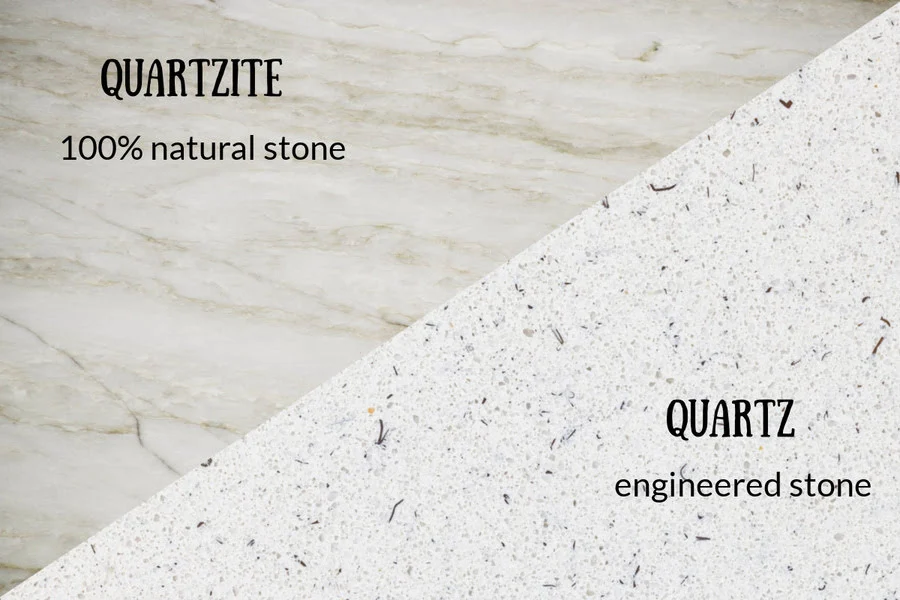
What Is Quartzite?
Quartzite is a natural metamorphic stone – originally sandstone that transformed under intense heat and pressure in the earth’s crust. This process fuses the sand grains and any minerals present into an extremely hard rock composed largely of quartz crystals. Quartzite slabs are quarried from mountains, similar to granite mining. Each slab is unique, featuring organic patterns and dramatic veining created by nature. Quartzite often has a marble-like appearance (soft whites, grays, or even bold hues with streaks of color) but is far harder and more resistant than marble.
In terms of hardness, quartzite ranks about 7 on the Mohs mineral hardness scale (sometimes even up to 8) – meaning it’s as hard as or harder than granite. This exceptional hardness makes it highly scratch-resistant and durable in high-traffic areas. It’s also very heat-resistant – having formed under heat, a quartzite countertop won’t be damaged by hot pots or pans; it can withstand extremely high temperatures (up to ~1000°F or ~538°C) without issue. Additionally, quartzite is UV-resistant, so its colors won’t fade in sunlight – this makes it suitable for outdoor use or sun-exposed areas.
Quartzite is used for much more than just kitchen counters. Thanks to its strength and beauty, it’s popular for flooring, wall cladding, stair treads, and even outdoor patios. Designers love using quartzite slabs for floors and staircases in luxury homes or commercial buildings, since it can handle heavy foot traffic with ease. It’s also used on walls and facades to create striking feature walls or building exteriors. You’ll find quartzite in table tops, bathroom vanities, fireplace surrounds, and other applications where a natural, elegant stone is desired. Because each piece of quartzite has unique veining and color, it lends a one-of-a-kind luxury feel to any space.
However, being natural, quartzite is porous to some degree. It needs sealing to protect against stains (unsealed quartzite can absorb wine, oils or other liquids). Typically, applying a penetrating stone sealer once or twice a year is recommended to keep it stain-resistant. With proper sealing and basic care, a quartzite countertop is relatively low maintenance and will last for decades (often 50+ years or more). In summary, quartzite is a premium natural stone known for its hardness, heat tolerance, and dramatic natural beauty.
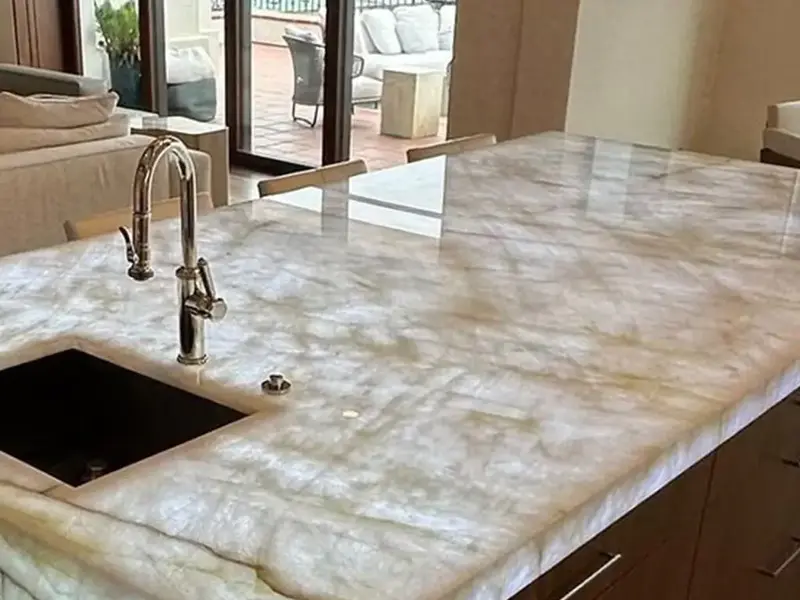
What Is Quartz?
Quartz refers to engineered quartz, a man-made composite stone product. Despite the name, it is not a solid slab of quartz mineral; rather, it’s about 90–94% ground natural quartz (silica) combined with 6–10% polymer resins and pigments. The mixture is formed into slabs and cured through a manufacturing process, creating a dense, non-porous surface. Brands like Silestone, Caesarstone, Cambria, etc., produce many of the quartz slabs on the market. Because it’s manufactured, pigments can be added to achieve a wide range of colours and patterns, including designs that mimic marble, granite, or concrete.
Engineered quartz is prized for its consistency and low maintenance. Each slab is uniform in pattern and color – what you see in a sample is what you get, with none of the natural imperfections or variability of a quarried stone. Many appreciate that they can select a specific colour (pure white, jet black, sparkly, you name it) and get exactly that. Quartz surfaces are non-porous, meaning they do not need sealing and are highly stain-resistant. Spills of wine, coffee, or oil won’t soak in, and cleanup is as simple as a wipe with mild soap and water. The non-porous nature also makes quartz more hygienic, as it doesn’t harbor bacteria in tiny pores.
Quartz is also quite hard and durable – the quartz crystals in it are Mohs hardness 7, so the slab resists scratches and chips in everyday use. However, because of the resin binders, engineered quartz is a bit less heat-resistant than natural stone. High heat can scorch or discolor the resin. In fact, quartz countertops can be damaged by temperatures around 300°F (~150°C) or above. This means you should never place hot pans directly on a quartz counter – always use trivets or hot pads to protect it. Similarly, quartz is not recommended for outdoor use because the resins are not UV-stable – prolonged exposure to sunlight can cause fading or warping, and most manufacturer warranties are void if used outdoors. In short, quartz is designed for indoor applications only.
Common uses for engineered quartz include kitchen countertops, island tops, and bathroom vanity tops. It’s also used for backsplashes, shower walls, and even as indoor wall cladding or decorative surfaces. Some homeowners use matching quartz slabs for everything from counters to shelves and tabletops to get a consistent look. While quartz can be used as flooring or stair treads, it’s not very common – the material is heavy and not usually produced in tile format, and manufacturers warn against using it in flooring with radiant heat (the constant heat could affect the resin over time). Overall, quartz’s sweet spot is interior surfaces where you want a beautiful, low-maintenance, and uniform material.
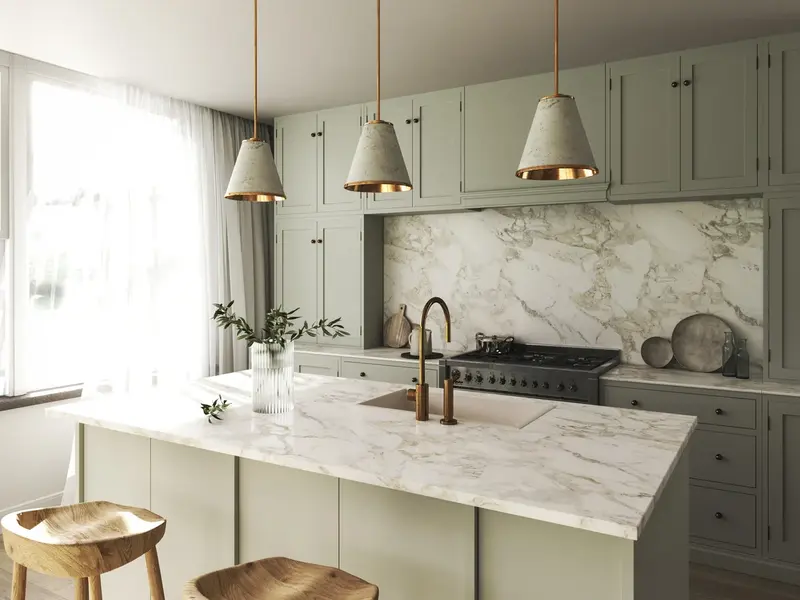
Quartz vs Quartzite: Key Differences
Now that we know what each material is, let’s compare quartz vs. quartzite directly. The table below highlights the key differences in various features:
| Feature | Quartz (Engineered) | Quartzite (Natural) |
|---|---|---|
| Material Type | Man-made engineered stone (~90% quartz mineral + resin). Fabricated in factories into slabs. | Natural metamorphic rock (sandstone transformed under heat/pressure); quarried from the earth. |
| Appearance | Quartz comes in many colours/patterns, often with consistent, even colouring. Can mimic marble or granite but has a manufactured look (patterns repeat). | Unique & organic – each slab has one-of-a-kind natural veining and color variation. Often looks like marble with dramatic swirls, created by nature (no two slabs are the same). |
| Hardness | ~Mohs 6.5–7. Very hard, resists scratches in daily use. The quartz crystals are hard, but the resin matrix is softer, so it’s slightly less hard than pure quartz or quartzite. Sharp objects generally won’t scratch it, but not completely scratch-proof. | Mohs 7+ (about 7 to 8). Extremely hard – harder than granite in many cases, and highly resistant to scratching. Will not scratch from knives or metal utensils (in fact it can scratch glass). |
| Heat Resistance | Moderate – resin binders can scorch or deform at ~150°C (300°F). Not safe for direct hot cookware; sudden high heat can cause discoloration or cracks. Always use trivets on quartz. | High – formed by heat, quartzite can withstand very high temperatures (~1000°F) without damage. You can place hot pots straight from the stove on it; it won’t scorch or burn (though using trivets is still wise to avoid thermal shock). |
| UV Resistance | Poor – not UV-stable, so not recommended outdoors. Direct sunlight over time can fade the colors or cause yellowing of resin. Best for indoor use only. | Excellent – UV-resistant. Quartzite will not fade or degrade in sunlight, making it great for outdoor kitchens, patios, or sunny rooms. |
| Porosity & Maintenance | Non-porous – never needs sealing. Highly stain-resistant surface; just wipe spills. Very low maintenance (routine cleaning with mild soap/water). However, cannot be repaired by repolishing if damaged, and seams are visible like any stone. | Porous natural stone – requires sealing periodically to prevent stains. Wipe up spills to avoid absorption. Moderate maintenance: use pH-neutral cleaners, avoid harsh chemicals, and reseal 1–2 times a year. Can be re-polished by a professional if needed over the years. |
| Weight/Density | ~2.4 g/cc density. Slabs are heavy but slightly lighter than quartzite. Typically easier to fabricate and install (less tool wear). Lighterweight means a bit less structural load on cabinets. | ~2.6–2.7 g/cc density. Denser and heavier stone; a 3 cm quartzite slab is heavier than a 3 cm quartz slab. Its density contributes to durability, but it’s more challenging to cut and install (fabricators must use diamond tools, and the slab weight is higher). |
| Outdoor Use | Mainly for indoor applications only (kitchens, baths, interiors). Exposure to weather or sun can damage it. Also, thermal expansion from outdoor temperature swings can be problematic for the resin. | Excellent for outdoors. Used in exterior countertops, building facades, outdoor pavers, etc. It handles sun, rain, and temperature extremes well (similar to granite). Just ensure proper sealing for outdoor use to prevent moisture staining. |
| Finish Options | Typically sold in polished or matte (honed)finishes. Some brands offer textured or “leathered” finishes, but options are limited by manufacturer. The surface finish is done in the factory. | Available in many finishes: polished, honed (matte), leathered (textured), even flamed or brushed. Because it’s natural stone, fabricators can apply different surface treatments. This allows for more design texture (e.g., a non-slip honed floor, or a glossy polished counter). |
In summary, quartzite is a natural, harder-than-granite stone with high heat/UV resilience, while quartz is an engineered, non-porous surface that prioritizes low maintenance and design consistency. Next, we’ll compare their costs, which is often a deciding factor.
Quartz and Quartzite Applications Beyond Countertops
When deciding between quartz and quartzite, consider all the ways you might use the material in your project. Both are versatile, but each has areas where it excels (or isn’t suitable). Here are some popular applications for each beyond just kitchen counters:
Quartzite Applications:
Because quartzite is basically a high-performance natural stone, it can be used almost anywhere you’d use granite or other sturdy stone.
Flooring
Quartzite is fantastic for floors – whether indoor flooring or outdoor patios. Its hardness means it won’t wear down easily even in high-traffic areas. It’s often used in luxury homes for living area or kitchen floors (polished for a formal look, or honed for a subtle elegance). It’s also used in hallways and entryways to make a grand statement and handle foot traffic.
Staircases
You can see quartzite as stair treads or steps, especially outdoors. For example, outdoor stairsmade of quartzite are durable and have a natural beauty. Interior staircases cladded in quartzite slabs are also seen in high-end designs.
Wall Cladding & Backsplashes
Quartzite slabs make stunning feature walls – say, a floor-to-ceiling fireplace surround, or an accent wall in a lobby. In bathrooms, quartzite can be used for shower walls (it gives a spa-like, natural vibe). Since it’s waterproof (when sealed) and heat-resistant, it’s great around fireplaces or as a backsplash behind a stove. Exterior building facades also use quartzite tiles or veneers for a natural stone look that withstands weather.
Tabletops & Furniture
A dining table or coffee table topped with a slice of quartzite can be a showpiece (imagine a beautiful quartzite with translucent areas that could even be backlit). Quartzite is sometimes used for furniture tops, like sideboards, consoles, or desk tops, to add a luxurious touch.
Outdoor Uses:
As mentioned, quartzite is right at home outside. It’s used for outdoor kitchen countertops, barbecue surrounds, patio bars, and poolside bars. Its slip-resistant versions (like a honed or brushed finish) can be used for pool decking or pool surrounds. It’s also common in exterior wall cladding or stone veneers on homes, giving the look of a natural stone facade.
Commercial applications:
Quartzite is used in hotels, resorts, and commercial buildings where a high-end natural stone is desired. You might find it in a hotel lobby floor or a wall feature in a high-rise office. Its ability to handle heavy use makes it suitable for such demanding settings.
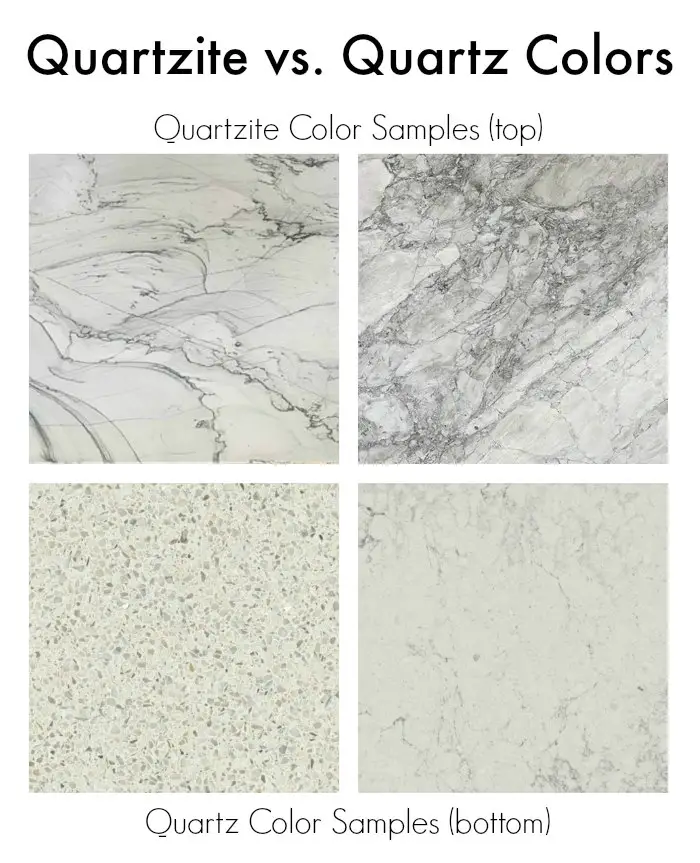
Quartz (Engineered Quartz) Applications:
Since quartz is fabricated, it’s mainly intended for interior uses where its properties shine.
Kitchen Countertops & Islands
This is the #1 use of quartz. It’s arguably the most popular kitchen countertop material in many countries now, due to its combination of looks and easy upkeep. Homeowners and designers use it for main counters, kitchen islands, and even waterfall islands (where the quartz slab flows over the side to the floor) because you can get that seamless, continuous look with uniform pattern.
Bathroom Vanities and Walls
Quartz is great in bathrooms – vanity countertops are a given, but also shower walls and tub surrounds. Large quartz slabs can be used on shower walls to minimize grout lines (some people choose quartz slabs instead of tiles for a sleek look and easy cleaning). Since quartz isn’t harmed by water and won’t stain from cosmetics, it’s very suitable here.
Backsplashes
A quartz slab backsplash in the kitchen (extending the same countertop material up the wall) is common. You can also use contrasting quartz colors as backsplash for design effect. Some homeowners do full-height backsplashes with quartz for a modern look. Quartz tiles (cut from slabs) can also be used if a pattern is desired.
Interior Wall Cladding
In retail or office settings, quartz slabs are sometimes used on interior walls or reception desks to create a dramatic, yet easy-to-clean surface. For example, a hotel front desk might be clad in a quartz that matches other decor. Fireplace surrounds indoors can use quartz too, as long as the fireplace design doesn’t expose the quartz to continuous direct flame or extreme heat (for gas fireplaces with proper insulation, quartz is often used decoratively around it).
Furniture & Misc
Quartz can be fabricated into table tops (like coffee tables, end tables, etc.), though it’s heavy. Some people use leftover pieces of their quartz slab to make small side tables or shelves. Window sills and thresholds are another small use – quartz remnants are often cut to make window ledges or door thresholds that match the counters. Shelves: Quartz slabs can be cut into floating shelves or used to make bench tops, etc., since it can be cut to custom shapes.
Commercial applications
You’ll find quartz in many restaurants and cafes (for bar tops and table tops) because it’s non-porous and hygienic. Also in medical facilities or laboratories, quartz is used for worktops because it resists staining and bacterial growth. In office buildings, quartz might be used for bathroom countertops or pantry areas. Basically, anywhere indoors that needs a durable, non-staining surface, quartz is a good fit, as long as high heat isn’t a factor.
One thing to avoid with quartz is any use where it’s exposed to the elements or extreme conditions – for example, do not use quartz for outdoor patio tables that sit in the sun/rain, or for around a fireplace where it touches open flames. Quartzite (or other natural stones or ceramics) would be better in those scenarios. Conversely, quartzite can be used in all the same places as quartz if you are willing to handle the maintenance. For instance, you can certainly use quartzite in a kitchen backsplash or a bathroom vanity – just remember it will need sealing, whereas quartz would not.
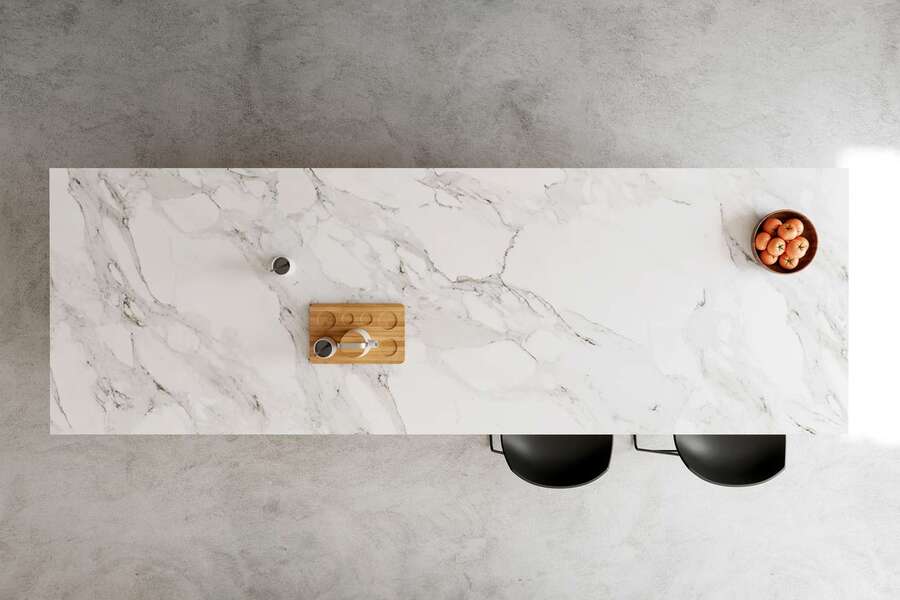
Quartz vs Quartzite: Cost Comparison
One common question is “Is quartzite more expensive than quartz?” In general, yes – quartzite tends to be pricier than quartz. Because quartzite is a natural stone that must be quarried from the earth and cut into slabs, its production cost is higher, and it’s considered a premium material. Engineered quartz is mass-produced in factories, allowing for more predictable pricing and often lower cost, especially for standard designs.
That said, the cost can vary widely depending on the specific material and other factors. High-end quartz (for example, a premium brand or a special design) can sometimes cost more than a basic quartzite. But looking at averages:
- In the U.S. market, quartzite countertops (material + install) often range around $65 to $190 per square foot, whereas quartz countertops typically range $60 to $150 per square foot. These figures include installation and can vary by region and project specifics.
- In the Indian market (where prices are often given per square foot of material), quartzite is also generally more expensive. For example, a supplier quotes ₹500–₹2500 per sq. ft. for quartzite slabs, while common engineered quartz slabs might be in the range of ₹240–₹650 per sq. ft. for standard thickness. These are raw material prices; fully installed countertops would be higher. The point is that quartzite usually starts at a higher price point than an equivalent size of quartz.
Why the difference? Quartzite’s cost is driven by the challenges of quarrying and cutting an extremely hard stone (it wears out diamond wires/blades and requires skilled labor), as well as its natural rarity and beauty. Each slab is unique, and certain colors of quartzite are only found in limited quarries.
Quartz’s cost is influenced by brand and design – for example, a quartz slab that perfectly mimics Calacatta marble with realistic veining might cost more than a plain quartz color due to R&D and demand – but overall, the manufacturing process allows for scaling up production and controlling costs.
When budgeting, also consider thickness and installation. Thicker 3 cm (1.25 inch) slabs cost more than 2 cm slabs in both materials. Quartzite, being heavier, might incur slightly higher install labor costs (and if a fabricator has a harder time cutting it, sometimes they charge a bit more for fabrication compared to an easier-to-cut stone). Quartz installation is fairly standard, but if you choose a very complex edge profile or full height backsplash, the labor could increase too.
In summary, quartz is usually the budget-friendlier choice for countertops, while quartzite is a luxury choice that commands a higher price. Keep in mind the total installed cost also involves fabrication and installation labor – be sure to get quotes for the whole job when comparing. Next, we’ll look at how each material performs in terms of durability in real-life use, which is an important aspect of value.

Quartzite vs Quartz: Pros & Cons
| Feature / Factor | Quartzite (Natural Stone) | Quartz (Engineered Stone) |
|---|---|---|
| Durability | Extremely hard (Mohs 7+), highly scratch-resistant — ideal for heavy-use areas | Strong and scratch-resistant for daily use, but slightly softer than quartzite |
| Heat Resistance | Can handle hot pans, grills, and high-heat areas comfortably | Sensitive to high heat due to resin — trivets recommended |
| Outdoor Suitability | Excellent for outdoor kitchens, steps, and facades — UV and weather-resistant | Not UV-stable — not suitable for outdoor use |
| Look & Appearance | Unique veining, natural movement, and premium aesthetics — no two slabs are the same | Uniform and customizable — available in solid colors and patterns, even marble-look styles |
| Maintenance | Needs sealing periodically to prevent staining — not high effort but requires care | Non-porous, stain-resistant, and zero sealing — very low maintenance |
| Hygiene | Naturally resistant to bacteria and easy to clean, though porous if unsealed | Non-porous and hygienic — ideal for kitchens and bathrooms |
| Color Availability | Limited to natural tones: whites, greys, golds, greens — depends on quarry source | Wide range: bright whites, dark tones, sparkles, vibrant colors — all factory-controlled |
| Weight & Fabrication | Very dense and heavy — requires expert handling and tools, more complex to cut | Easier to fabricate and transport due to flexibility and lower density |
| Cost | Usually more expensive per sq ft — rare varieties can command high prices | Often more affordable than quartzite — competitive across brands |
| Eco-Friendliness | 100% natural stone — minimal processing if sourced responsibly | Contains resin and pigments — some brands use recycled material, but not fully natural |
| Ideal Use Cases | Flooring, wall cladding, staircases, outdoor counters, feature walls, high-end kitchens | Kitchen countertops, vanities, commercial interiors, indoor shelving |
| Seam Visibility | Veining and patterns can hide seams better if matched properly | Uniformity can make seams more visible in long runs or corners |
| Overall Appeal | Premium, natural, timeless — adds real estate value and design impact | Practical, modern, versatile — easy to match with design schemes and fast turnaround |

Which One Should You Choose?
Choosing between quartz and quartzite depends on where you're using the stone, your design goals, and how much maintenance you're okay with.
Indoor or Outdoor Use
If the surface will face sun, rain, or heat (like BBQ counters or exterior stairs), go for quartzite — it's natural, UV-stable, and heat-resistant. Quartz is better suited for indoor kitchens, bathrooms, or wall panels.
Look and Style
Prefer natural variation and veining? Choose quartzite — each slab is unique. Want uniform color or bold tones like pure white, red, or deep blue? Quartz gives you that consistent, engineered finish.
Maintenance Level
Quartz is low-maintenance and doesn’t need sealing — perfect for busy homes. Quartzite needs annual sealing and quick cleanup, but rewards you with long-term durability and natural appeal.
Cost Consideration
Quartz is generally cheaper upfront. Quartzite may cost more depending on rarity and finish, but offers longer lifespan and resale value. For budget balance, many combine both — quartz on the perimeter, quartzite for a showpiece island.
Design Harmony & Timeline
Minimalist design? Go with subtle quartz. Want a natural focal point? Quartzite works great. Quartz is easier to source and fabricate fast, while quartzite may take time to select and cut.
India’s Growing Role in Quartzite & Quartz Supply Chain
Brazil remains a major source of exotic quartzites such as Blue Macaubas and Fusion. India — particularly Rajasthan — is becoming a key processor and supplier of these exotic quartzites, as many of them are quarried locally in this region, like Patagonia, Crystallo, Cosmopolitan, Maharaja White, and Bali Blue. These quartzite types are found within India, eliminating the need for import.
With the development of modern processing units, resin treatment lines, and skilled labor, Indian factories are now capable of transforming raw quartzite blocks into polished slabs ready for global projects. This positions India not only as a source of quarry material but also as a reliable processing hub for exotic quartzites. For global buyers and architects, this translates into shorter lead times, consistent output, and streamlined logistics for high-demand natural stones.
Engineered quartz, by contrast, follows a global supply chain. Following tariffs imposed by the US on Chinese quartz, manufacturing activity expanded to countries like Vietnam, India, and Turkey. India now exports a growing volume of engineered quartz slabs under both OEM and private label brands, meeting international demand across residential and commercial markets.
Conclusion
Quartz and quartzite are both excellent countertop materials, but they are far from interchangeable. In the quartz vs. quartzite debate, there is no outright winner – the best choice truly depends on your priorities and application:
- If you value natural beauty, uniqueness, and maximum durability (especially against heat or outdoor elements), quartzite is a fantastic choice. It gives you a piece of nature’s artistry in your home, and it will stand up to heavy use and time. You’ll need to put in a little effort to maintain its seal and care, but it can reward you with a lifetime of service and timeless elegance.
- If you value ease of maintenance, a precise and consistent look, and a lower upfront cost, quartz (engineered)is likely the better choice. It offers a no-fuss solution – install it and enjoy it without worrying about sealing or most stains. It comes in almost any style you can imagine, so it’s easy to match your design vision. Just remember to keep it away from extreme heat and sun, and it will perform beautifully for many years.
At the end of the day, both quartz and quartzite will elevate the look of a kitchen, bathroom, or any space when used properly. They each have their pros and cons, but neither will be a “bad” choice. It often comes down to a personal preference: some love the idea of a real natural stone that has its own character, while others love the convenience and clean look of an engineered product.
When making your decision, consider doing the following: see and touch samples of each – the tactile feel and visual depth of quartzite versus quartz can be different. Visit a stone showroom if possible; seeing a full slab of quartzite in all its natural glory might sway you, or conversely, you might fall in love with a particular quartz design. Think about your lifestyle – are you okay with remembering to seal and not leaving spills, or do you need something ultra-forgiving? Also consider mixing materials if it suits your needs (you don’t necessarily have to pick only one or the other for the whole project).
In summary, quartzite and quartz each have merit, but they are not the same. By understanding their differences – natural vs engineered, porous vs non-porous, unique vs uniform, etc. – you can make an informed choice that you’ll be happy with. Whether you opt for the natural charm of quartzite or the modern convenience of quartz, you’ll be getting a high-quality surface that enhances your space for years to come. Enjoy your beautiful new countertops!


 Fact Checked
Fact Checked




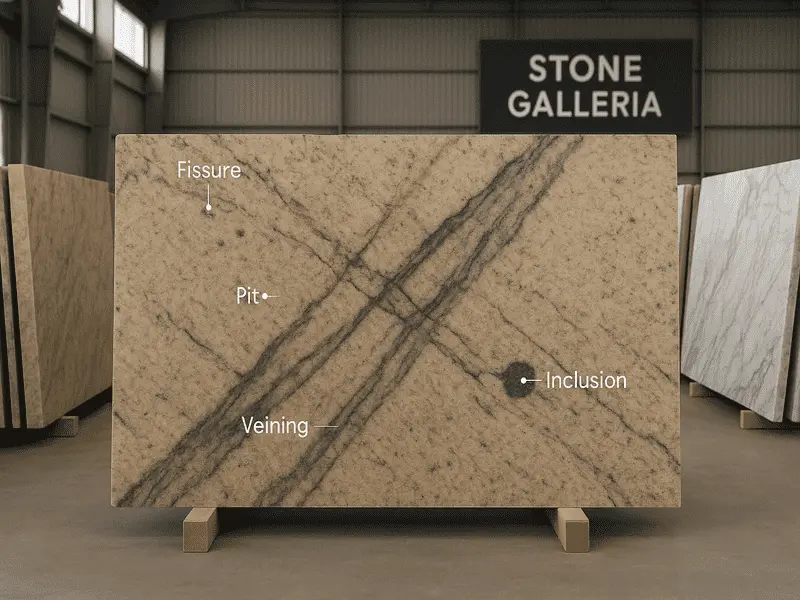
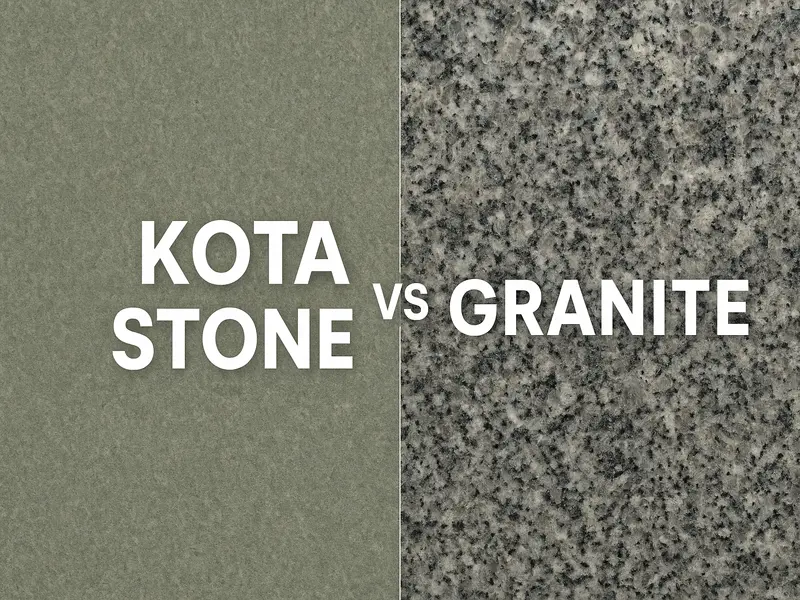



![Latest GST on Granite Slabs & Blocks [2025 Chart + HSN + Price Examples]](https://stonegalleria.in/admin/images/blog/latest-gst-on granite.webp)




